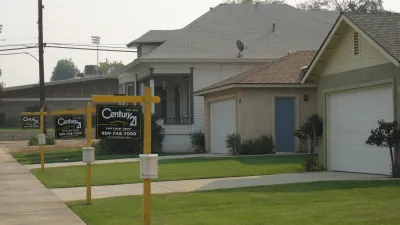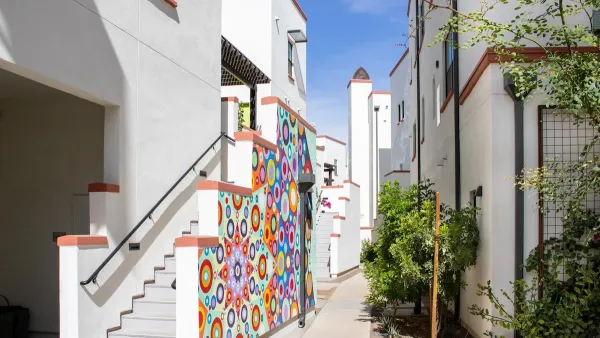In addition to revealing public preferences for single-family homes and walkable communities, a recent survey conducted for the National Association of Realtors contains a variety of other small surprises.

A recent survey conducted for the National Association of Realtors contains a great deal of information on the housing preferences of Americans. The findings that have received the most publicity are respondents' strong preference for single-family homes and their preference that those homes be in walkable locations (that is, places within walking distance of shops and public transportation). However, a few other findings struck me as noteworthy:
*The issues that smart growth supporters and critics care about are quite low on the priority list. When given a list of issues and asked to identify them as "extremely high", "high", "middle", "low" or "extremely low" priorities, only 47 percent of all respondents picked reducing traffic congestion (a high priority of smart growth critics) as a "extremely high" or "high" priority- lower than all but three of fourteen items listed. On the other hand, smart growth priorities such as "revitalizing cities" and "providing convenient alternatives to driving" did no better, and even "preserving farms and open spaces from development" (the highest-ranking smart growth priority) was picked as a high priority by 54 percent of respondents- lower than improving job creation (the highest priority out of all fourteen) health care, reducing government spending, lowering crime rates, improving public education, environmental protection, or affordable housing.
*Most people were satisfied with the level of neighborhood amenities, though a healthy minority wanted more of everything. When asked whether their neighborhood had too much, the right amount, or too little of twelve amenities (ranging from sidewalks to safe bike routes to parks) a plurality picked "the right amount" for every amenity but three- thus indicating a high level of satisfaction with the status quo.
On the other hand, a plurality believed that there were too few "Safe routes for riding bikes to work and shopping" and "Housing for people of low incomes". Thus, it may be that NIMBY resistance to bike lanes or low-income housing does not represent the majority of most communities. Even where the "just right" respondents outnumbered the "too little" respondents, more people said there was "too little" of most amenities than thought there was "too much." for example, 17 percent of people thought there were too many new apartments and houses in their neighborhood, but they were outnumbered by the 26 percent who said there were too few. (The sole exception to this rule was high-income housing: 28 percent said there was too much such housing, 11 percent said there was too little).
*Even though people claim to prefer large houses and yards, they don't really care too much about house size. When asked whether house size or a neighborhood are more important, 78 percent chose "neighborhood."
*Walkability beats transit. The most widely publicized part of the Realtors' survey is the response to the "trade off" question: when people were asked to choose between a "sprawl neighborhood" where nothing is within walking distance of a house except more houses, and a mixed-use area where shopping and schools are only a few blocks away, the "smart growth" alternative was more popular.
I have seen less publicity given to a follow-up question: when respondents who chose the smart growth community were asked what the most appealing characteristic of that community was, 64 percent chose "Places such as shopping, restaurants, a library and a school are within a few blocks of your home." By contrast, only 19 percent cared more about a mix of housing types, and 11 percent cared more about public transit nearby.
This statistic explains why greenfield new urbanism is so popular: people may want transit within walking distance, but if a lot of other things are within walking distance, most will overlook that flaw. Even the sprawl supporters had similar priorities in this regard: when asked what the most appealing characteristic of the smart growth community was, 54 percent chose walking distance to amenities while 11 percent chose public transit.
*When given a broader list of factors, people value sidewalks, schools and privacy. When asked whether nineteen factors would be "very important, somewhat important, not very important, or not at all important", 46 percent chose "Privacy from neighbors" as "very important"- perhaps because this is such a broad concept. (For example, I live in a rather anonymous high-rise tower, and think that I probably have more privacy than many suburbanites). "High quality public schools" was second (45 percent) and "Sidewalks and places to take walks" were third (37 percent). By contrast, "Having a large house" was fifth from the bottom at 18 percent. Since only 1/3 of respondents actually had children, I was surprised by the high ranking of schools: my guess is that respondents were thinking about where they would live if they did have children.
*Fix it first. When asked to rate the importance of expanding highways, maintaining local roads, expanding buses, expanding sidewalks and bike lanes, and providing public transportation, street maintenance was a clear first priority. Respondents were asked to rank these policies on a scale between 1 (not important) and 5 (extremely important). 48 percent of the respondents rated street maintenance as a 5 ("extremely important), while the other four options were in a statistical four-way tie: each of them were given a 5 by between 25 and 30 percent of respondents.
*Taxophobia may be weaker than I thought. When asked whether they would pay "a little more in taxes" for new roads, new sidewalks, expanded public transit, or better quality and service of existing transit, a slight plurality (between 46 and 51 percent) answered yes for all four. Surprisingly, the poll failed to ask about street maintenance.
*Although most respondents treat car dependence as natural, a large minority hope to use transit more regularly. When asked if they would like a different means of getting to work, 49 percent said "yes." Some of those where transit users who wanted to drive, but 27 percent of that 49 percent (or 13%, about three times the current transit mode share) preferred to take transit, and 16 percent hoped to walk or bike.

Analysis: Cybertruck Fatality Rate Far Exceeds That of Ford Pinto
The Tesla Cybertruck was recalled seven times last year.

National Parks Layoffs Will Cause Communities to Lose Billions
Thousands of essential park workers were laid off this week, just before the busy spring break season.

Retro-silient?: America’s First “Eco-burb,” The Woodlands Turns 50
A master-planned community north of Houston offers lessons on green infrastructure and resilient design, but falls short of its founder’s lofty affordability and walkability goals.

Test News Post 1
This is a summary

Analysis: Cybertruck Fatality Rate Far Exceeds That of Ford Pinto
The Tesla Cybertruck was recalled seven times last year.

Test News Headline 46
Test for the image on the front page.
Urban Design for Planners 1: Software Tools
This six-course series explores essential urban design concepts using open source software and equips planners with the tools they need to participate fully in the urban design process.
Planning for Universal Design
Learn the tools for implementing Universal Design in planning regulations.
EMC Planning Group, Inc.
Planetizen
Planetizen
Mpact (formerly Rail~Volution)
Great Falls Development Authority, Inc.
HUDs Office of Policy Development and Research
NYU Wagner Graduate School of Public Service




























